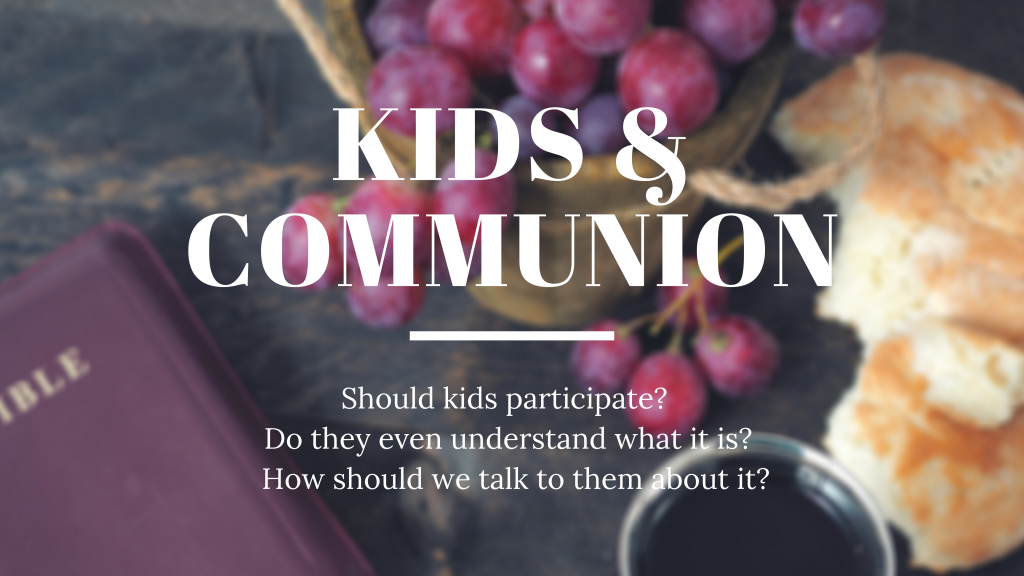I found out recently that there was (not too long ago) quite a rigorous discussion over whether children should participate in communion in church services. Here are some thoughts and tips…

What is communion? The Lord Jesus, on the night he was betrayed, took bread, and when he had given thanks, he broke it and said, “This is my body, which is for you; do this in remembrance of me.” In the same way, after supper he took the cup, saying, “This cup is the new covenant in my blood; do this, whenever you drink it, in remembrance of me.” For whenever you eat this bread and drink this cup, you proclaim the Lord’s death until he comes. 1 Corinthians 11:23-26
Communion is the ceremonial sacrament instituted by Jesus to remember his sacrifice over a meal shared among believers. Communion is a common (communal sharing) union (oneness) in the unique, once-for-all, substitutionary death of Jesus. It provides an opportunity for believers to come together, examining their hearts before God, and share a meal as God’s family, remembering the eternal hope Jesus secured for us on the cross.
The communion sacrament is a beautiful one because of its visuality. Christ himself proclaimed that he was the bread of life (John 6:35) and living water (John 4:14) and he promises that those who come to him will neither hunger nor thirst again. As we participate in communion, we feast on the very symbols that Jesus uses to describe himself. While the bread and wine posses no power in and of themselves, they are wonderful, tangible symbols of Christ and our communion with him.
In essence, the meal of communion itself is a symbolic representation of the common union we all have in Christ presently.
“The communion sacrament is a beautiful one because of its visuality. Christ himself proclaimed that he was the bread of life (John 6:35) and living water (John 4:14) and he promises that those who come to him will neither hunger nor thirst again. As we participate in communion, we feast on the very symbols that Jesus uses to describe himself. ”
Developmentally speaking… This begs the question can a child understand the symbolism of the communion meal?According to child psychologist and theorist, Jean Piaget’s theory of cognitive development, there are four stages of development in children that characterise a child’s learning in they area. When this theory is applied to the concept of communion, we see children able to engage as follows:
Children of all ages use symbols in day to day life. A baby’s babble is a representation of words. A toddler’s scribbling is a signifier of what object or word they are creating on the page. A preschooler’s imaginative play is symbolic representation as they create their own meal in the home corner or a castle in the sandpit. A child in primary school has begun experimenting with the use of numbers and letters that symbolise sounds or values as well as using them to createmeaning.
When it comes to the BibleDevelopmentally speaking, the Bible is one of, if not the most, universally rich texts that holds out complex, multifaceted, nuanced ideas while those same ideas are beautifully simple – to the point where a child can fully understand those same concepts in their entirety. However the true beauty of the Bible lies in the fact that we are not dealing with abstract concepts alone. We are not engaging our kids in purely theoretical abstractions. When we are teaching communion, we are teaching our kids to meet with Jesus – to commune with Jesus – as a family. The importance for a child’s understanding does not lie so much in the symbols themselves, but rather in the use of these symbols to relay their life-transforming message. So as we interact with our children on any topic in the Bible, but especially communion, we can rest in the knowledge that even the youngest of children can engage with the meaning of communion; to meet with Christ.
Even if they don’t understand… Conversely, in an article by Glenn Davies (now Archbishop Davied) in 1995 spells out why, even if it is the case that children do not cognitively comprehend the theology behind communion, there is still great value in children participating alongside adults
In 1 Corinthians 10:3-4 we see all of Israel in the wilderness and their collective experiences as ‘spiritual participation’ in Christ. “The repetition of the word ‘all’, Davies argues, “is instructive: all passed under the cloud, all passed through the sea, all were baptised into Moses, all ate the same spiritual food, all drank the same spiritual drink… All participated in the covenantal signatures of salvation and communion with God. It was not only the ‘cognitively aware’ who received these blessings.” Children are included in the people of God under the old covenant. If we really do hold to the doctrine of one body (Romans 12:1-8; 1 Corinthians 12; Ephesians 3:6) which includes our children, then the aspect of our regular services in which we see the most vivid symbolism of that one body – the breaking of bread together – should be spoken about with our children as they are given the opportunity to feed on Christ.
ENGAGING YOUR KIDS IN COMMUNION
1. Talk about it! If your child has never heard you speak of or connect with communion in any meaningful way, then it will have little to no meaning in your child’s life, except perhaps as an arbitrary ritual. When we create a conversation with our kids, not just engage them in the action, we end up prompting long term understanding, more than just pure participation. Ask open ended questions and gauge their understanding; “Have you heard of communion?”, “What do you know about it?”, “Why do you think we do it?”. All the while, use language that grounds the conversation in symbolism where “is the body of Christ, was the blood spilled” language is replaced for “stands for/ is like/ represents the body and blood of Jesus”.
2. Ground your conversation in the Bible Open the Bible and bring Jesus’ words into your conversations. Read Luke 22 and 1 Corinthians 11 together. Particularly, ground your conversation in biblical language that is accessible for children. The following are helpful versions and translations for different ages-
- 0-5 year olds: Jesus Storybook Bible; Big Picture Story Bible
- 5-8 year olds: International Children’s Bible (ICB)
- 8-12 year olds: Contemporary English Version (CEV)
3. Lead by example in self examination Paul exhorts us to take the Lord’s Supper seriously and makes clear that “everyone ought to examine themselves before they eat of the bread and drink from the cup. For those who eat and drink without discerning the body of Christ eat and drink judgement on themselves” (1 Corinthians 11:28). We need to be models of self-examination and confession of sin. But this requires a willingness to be spiritual vulnerable with your children.
Using language such as “I have disobeyed God”, “I haven’t done what God would want me to do” or “I know God doesn’t like what I just said/did” to describe your own sinful behaviour will help children see your own self-examination in action. Be aware that your children are watching everything you do and unrepentant sin or unreconciled Christian relationships are not only reasons to think twice about receiving communion but are also models to children of an unwillingness to admit your imperfection. We need to be honest; firstly with God and secondly, with our children, resting in the knowledge that “the Lord longs to be gracious to you” (Isaiah 30:18).
4.Give meaning to the symbolsAccording to Augustine, biblical symbols uses what is seen and understood to grasp what is an unseen mystery, where “what is seen is a mere physical likeness; but what is grasped bears spiritual fruit.” The use of symbolism in God’s word helps us more fully and richly see the character of God – as used to great effect by Jesus in his parables. Symbolism brings colour and life to biblical concepts. So we, as adults, need to give meaning to the ceremonial symbolism in order for that representation to connect deeply with our kids. The images of the bread (Jesus’ body broken in half); the wine (his blood, shed to offer us eternal life) are intense and life-changing ones. Let’s use the gift of God’s symbolic narrative to help bring the significance of communion – and indeed all biblical truths – alive for our kids.
5. Eliminate the “kids table” mentality In the body of Christ there is no such thing as second rate. Regardless of age, ability, wealth, intelligence, cultural heritage, gender, ALL are welcome at the same table to commune with the same Lord Jesus. Yes, it can be messy but when we say ALL, let’s mean ALL. Just as Jesus welcomed the children to come to him (Matthew 19), let’s ensure our churches services welcome children to come and participate, in all of their energetic, noisy, wonderfully unique glory.
6. When in doubt, ask!Kids Space’s vision for our ministry is to be here to partner with you in discipling your children. We want to walk with you as you lead them towards Jesus. If you’re kids are asking questions that you don’t know the answer to, or if you think they aren’t really getting it – come talk to us! We would love to be able to pray with you, point you to resources and continue the conversation with your kids.
